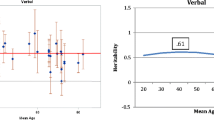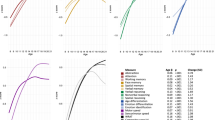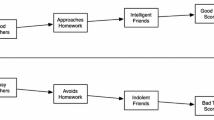Abstract
Longitudinal studies document an association of pulmonary function with cognitive function in middle-aged and older adults. Previous analyses have identified a genetic contribution to the relationship between pulmonary function with fluid intelligence. The goal of the current analysis was to apply the biometric dual change score model to consider the possibility of temporal dynamics underlying the genetic covariance between aging trajectories for pulmonary function and fluid intelligence. Longitudinal data from the Swedish Adoption/Twin Study of Aging were available from 808 twins ranging in age from 50 to 88 years at the first wave. Participants completed up to six assessments covering a 19-year period. Measures at each assessment included spatial and speed factors and pulmonary function. Model-fitting indicated that genetic variance for FEV1 was a leading indicator of variation in age changes for spatial and speed factors. Thus, these data indicate a genetic component to the directional relationship from decreased pulmonary function to decreased function of fluid intelligence.





Similar content being viewed by others
References
Albert MS, Jones K, Savage CR, Berkman L, Seeman T, Blazer D et al (1995) Predictors of cognitive change in older persons: MacArthur studies of successful aging. Psychol Aging 10(4):578–589
Anstey KJ, Windsor TD, Jorm AF, Christensen H, Rodgers B (2004) Association of pulmonary function with cognitive performance in early, middle and late adulthood. Gerontology 50(4):230–234
Bryk AS, Raudenbush SW (1992) Hierarchical linear models. Sage Publications, London
Chowdhary R, Tan SL, Pavesi G, Jin J, Dong D, Mathur SK, Burkart A, Narang V, Glurich I, Raby BA, Weiss ST, Wong L, Liu JS, Bajic VB (2012) A database of annotated promoters of genes associated with common respiratory and related diseases. Am J Respir Cell Mol Biol 47:112–119
Chyou PH, White LR, Yano K, Sharp DS, Burchfiel CM, Chen R et al (1996) Pulmonary function measures as predictors and correlates of cognitive functioning in later life. Am J Epidemiol 143(8):750–756
Colcombe S, Kramer AF (2003) Fitness effects on the cognitive function of older adults: a metal-analytic study. Psychol Sci 14:125–130
Davies G, Tenesa A, Payton A, Yang J, Harris SE, Liewald D et al (2011) Genome-wide association studies establish that human intelligence is highly heritable and polygenic. Mol psychiatry 16(10):996–1005
Deary IJ, Johnson W, Gow AJ, Pattie A, Brett CE, Bates TC, Starr JM (2011) Losing one’s grip: a bivariate growth curve model of grip strength and nonverbal reasoning from age 79 to 87 years in the Lothian Birth Cohort 1921. J Gerontol 66B:699–707
Emery CF, Huppert FA, Schein RL (1997) Do smoking and pulmonary function predict cognitive function? Findings from a British sample. Psychol Health 12:265–275
Emery CF, Pedersen NL, Svartengren M, McClearn GE (1998) Longitudinal and genetic effects in the relationship between pulmonary function and cognitive performance. J Gerontol 53(5):P311–P317
Emery CF, Finkel D, Pedersen NL (2012) Pulmonary function as a leading cause of cognitive aging. Psychol Sci 23:1024–1032
Finkel D, Pedersen NL (2004) Processing speed and longitudinal trajectories of change for cognitive abilities: the Swedish Adoption/Twin Study of Aging. Aging Neuropsychol Cogn 11:325–345
Finkel D, Reynolds CA, McArdle JJ, Pedersen NL (2005) The longitudinal relationship between processing speed and cognitive ability: genetic and environmental influences. Behav Genet 35:535–549
Finkel D, Reynolds CA, McArdle JJ, Pedersen NL (2007) Age changes in processing speed as a leading indicator of cognitive aging. Psychol Aging 22:558–568
Finkel D, Reynolds CA, McArdle JJ, Hamagami F, Pedersen NL (2009) Genetic variance in processing speed drives variation in aging of spatial and memory abilities. Dev Psychol 45:820–834
Gatz M, Pedersen NL, Berg S, Johansson B, Johansson K, Mortimer JA, Posner SF, Viitanen M, Winblad B, Ahlbom A (1997) Heritability for Alzheimer’s disease: the study of dementia in Swedish twins. J Gerontol 52A:M117–M125
Ghisletta P, de Ribaupierre A (2005) A dynamic investigation of cognitive dedifferentiation with control for retest: evidence from the Swiss Interdisciplinary Longitudinal Study of the Oldest Old. Psychol Aging 20:671–682
Laird NM, Ware H (1982) Random-effects models for longitudinal data. Biometrics 38:963–974
Lövdén M, Ghisletta P, Lindenberger U (2005) Social participation attenuates decline in perceptual speed in old and very old age. Psychol Aging 20:423–434
McArdle JJ (2001) A latent difference score approach to longitudinal dynamic structural analyses. In: Cudeck R, duToit S, Sorbom D (eds) Structural equation modeling: present and future. Scientific Software International, Lincolnwood, pp 342–380
McArdle JJ, Anderson E (1990) Latent variable growth models for research on aging. In: Birren JE, Schaie KW (eds) Handbook of the psychology of aging, 3rd edn. Academic Press, New York, pp 21–44
McArdle JJ, Hamagami F (2003) Structural equation models for evaluating dynamic concepts within longitudinal twin analyses. Behav Genet 33:137–159
McArdle JJ, Prescott CA, Hamagami F, Horn JL (1998) A contemporary method for developmental-genetic analyses of age changes in intellectual abilities. Dev Neuropsychol 14:69–114
McArdle JJ, Hamagami F, Meredith W, Bradway KP (2000) Modeling the dynamic hypotheses of Gf–Gc theory using longitudinal life-span data. Learn Individ Differ 12:53–79
McArdle JJ, Hamagami F, Jones K, Jolesz F, Kikinis R, Spiro A III, Albert MS (2004) Structural modeling of dynamic changes in memory and brain structure using longitudinal data form the normative aging study. J Gerontol: Psychol Sci 59B:294–304
McGue M, Christensen K (2001) The heritability of cognitive functioning in very old adults: evidence from Danish twins aged 75 years and older. Psychol Aging 16:272–280
McGue M, Johnson W (2007) Genetics of cognitive aging. In: Craik FIM, Salthouse TA (eds) Handbook of aging and cognition, 3rd edn. Lawrence Erlbaum Associates, Hillsdale
Neale MC, Cardon LR (1992) Methodology for genetic studies of twins and families. Kluwer Academic Publishers, London
Neale MC, Boker SM, Xie G, Maes HH (2003) Mx: statistical modeling, 6th edn. Department of Psychiatry, Richmond
Nesselroade JR, Pedersen NL, McClearn GE, Plomin R, Bergeman CS (1988) Factorial and criterion validities of telephone-assessed cognitive ability measures: age and gender comparisons in adult twins. Res Aging 10:220–234
Pedersen NL, Reynolds CA (1998) Stability and change in adult personality: genetic and environmental components. Eur J Pers 12:365–386
Pedersen NL, Plomin R, Nesselroade JR, McClearn GE (1992) Quantitative genetic analysis of cognitive abilities during the second half of the lifespan. Psychol Sci 3:346–353
Plomin R, DeFries JC, McClearn GE, McGuffin P (2001) Behavioral genetics, 4th edn. Worth Publishers, New York
Reynolds CA, Finkel D, Gatz M, Pedersen NL (2002) Sources of influences on rate of cognitive change over time in Swedish twins: an application of latent growth models. Exp Aging Res 28:407–433
Reynolds CA, Finkel D, McArdle JJ, Gatz M, Berg S, Pedersen NL (2005) Quantitative genetic analysis of latent growth curve models of cognitive abilities in adulthood. Dev Psychol 41:3–16
Richards M, Strachan D, Hardy R, Kuh D, Wadsworth M (2005) Lung function and cognitive ability in a longitudinal birth cohort study. Psychosom Med 67(4):602–608
Schaie KW (1965) A general model for the study of developmental problems. Psychol Bull 64:91–107
Schaie KW (1970) A reinterpretation of age related changes in cognitive structure and functioning. In: Goulet LR, Baltes PB (eds) Life-span developmental psychology: research and theory. Academic Press, New York, pp 485–507
Smiley-Oyen A, Lowry K, Francois S, Kohut M, Ekkekakis P (2008) Exercise, fitness, and neurocognitive function in older adults: the “selective improvement” and “cardiovascular fitness” hypotheses. Ann Behav Med 36:280–291
Tucker-Drob E, Reynolds CA, Finkel D, Pedersen NL Shared and unique genetic and environmental influences on changes in multiple cognitive abilities over 16 years of late adulthood. Dev Psychol (in press)
Wicherts JM, Dolan CV, Hessen DJ, Oosterveld P, van Baal GCM, Boomsma DI, Span MM (2004) Are intelligence tests measurement invariant over time? Investigating the nature of the Flynn effect. Intelligence 32:509–537
Zimprich D, Martin M (2002) Can longitudinal changes in processing speed explain longitudinal age changes in fluid intelligence? Psychol Aging 17(4):690–695
Acknowledgments
The Swedish Adoption/Twin Study of Aging (SATSA) is supported by NIA (AG04563, AG10175), The MacArthur Foundation Research Network on Successful Aging, the Swedish Council for Social Research (97:0147:1B), and the Swedish Research Council.
Author information
Authors and Affiliations
Corresponding author
Additional information
Edited by Kristen Jacobson.
Rights and permissions
About this article
Cite this article
Finkel, D., Reynolds, C.A., Emery, C.F. et al. Genetic and Environmental Variation in Lung Function Drives Subsequent Variation in Aging of Fluid Intelligence. Behav Genet 43, 274–285 (2013). https://doi.org/10.1007/s10519-013-9600-3
Received:
Accepted:
Published:
Issue Date:
DOI: https://doi.org/10.1007/s10519-013-9600-3




